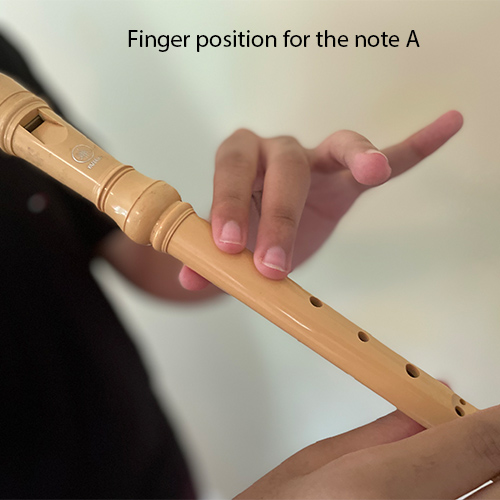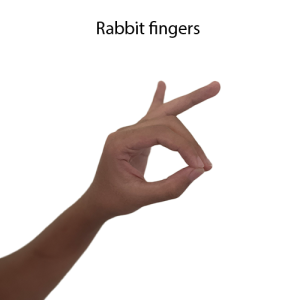Y3. Lesson 4. Practise note names on lines & in spaces
Prior learning: Treble clef
Duration: 30 minutes
Materials: Recorders
Keywords: Beat, rhythm, singing, chanting, partners, rhymes, circle games.
Difficulty: ![]()
Prepare
Present
Practise
Notes on lines and in spaces
 Melodic development
Melodic development
![]() Students explore the note names of a known song.
Students explore the note names of a known song.
- Lead the class in singing Bow Wow Wow.
- Project, print or draw the score without the note names.
- Ask the class what the four notes in a space are called [FACE].
- Point to the first notes and ask their name.
- Ask a student to come forward and draw the letters.
- Repeat for the notes in the next measure.
- Repeat for the third measure.
- The third measure has a note that is not in a space but on a line.
- Ask students what this note might be [D].
- Ask students what the notes in the last measure are. Again, apart from A and G, which sit in spaces, one note sits on a line [G].
- Ask students to copy the first two measures in their notebooks.
 Rhythmic development
Rhythmic development
![]() Students discover the missing parts of a song.
Students discover the missing parts of a song.
- Project the score of Apple Tree and lead the class in singing the song.
- Referring to the score, ask students to identify whether the song is in duple metre or quadruple metre [duple].
- Ask what is missing at the first question mark [a 2 for duple metre]
- Ask what is missing at the second question mark [a repeat of the melody of the words 'Apple tree'].
- Ask what is missing at the third question mark [the notes for 'fall on me'].
- Ask what is missing at the fourth question mark [the notes for 'I won't shout'].
- Ask what is missing at the fifth question mark [a double bar line].
- Students should write the song in their notebooks with the missing parts included.
 Creative movement
Creative movement
![]() Students form two circles and sing the song in canon.
Students form two circles and sing the song in canon.
- Students form two circles, with a smaller one inside the other.
- Students are to sing the song, starting with the first inner circle who move clockwise.
- The outer circle join in as a canon, starting two beats later and moving anticlockwise.
- Each group should jump on the word 'boom'.
- As soon as each group finishes they repeat the song, but reversing their original direction.
- Repeat as time permits.
 Listening
Listening
![]() Students listen to the beginning of Beethoven's Fur Elise.
Students listen to the beginning of Beethoven's Fur Elise.
- "Fur Elise," composed by Ludwig van Beethoven, is a renowned piano piece cherished by many. This enchanting melody captures the imagination, evoking a sense of wonder and tranquillity.
- Play the track and ask students to close their eyes.
- When finished, ask students how they felt about the music. What did they wonder?
- Teach that the composer was German and called Ludwig van Beethoven
- Ask what instrument was being played.
 Visual learning
Visual learning
![]() Students name the notes in a simple melody.
Students name the notes in a simple melody.
- Project, print or draw the melody on the board.
- Ask a volunteer to name the first note on the line [E].
- Continue with another student for the next note.
- When the series is complete ask if students can discover a pattern between each pair of notes [alternate lines and spaces].
- Ask how many E notes are shown [2]. Do these notes sound the same?
- Ask how many F notes are shown [2]. Do these notes sound the same?

 Instruments
Instruments
![]() Students discover a new note on the recorder, A.
Students discover a new note on the recorder, A.


- Show students how to hold the recorder using Rabbit fingers, with the first and second left-hand fingers covering the first and second holes on the instrument.
- This fingering will produce the note A when students blow gently.
- With the recorder in their mouths, ask students to say the word 'too' in a whisper when they play a note. Explain this is called tonguing, which separates the notes.
- Have the class practice tonguing as they play the note A.
- Project or print the score for the song called A-mazing.
- Students should play the first two A notes with a rest in between. The three A notes and a rest, four A notes, and finally two separated by rests.
- Remind students to count 1-2-3-4 in their heads as they play.
- The comma marking denotes where a breath should be taken.
 Part work
Part work
![]() Students sing this classic pentatonic song in canon.
Students sing this classic pentatonic song in canon.
- Divide the class into girls and boys.
- Explain that the song will be sung in canon.
- Lead the girls who should begin the song on your conducting command.
- After one measure the boys should begin singing.
- The class should repeat, with the roles swapping over.
- The audio player shows the effect of the canon.
 Assess
Assess
Suggested lessons
Y1. Beat II

Y1. Beat III

Y1. Beat IV

